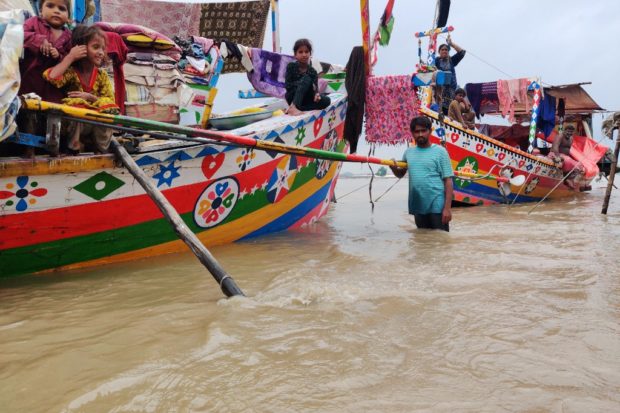
People take shelter on their boats after the Sindh River water levels rose following monsoon rainfalls in Sukkur, in Sindh province on August 24, 2022. Record monsoon rains were causing a “catastrophe of epic scale”, Pakistan’s Climate Change Minister said August 24, announcing an international appeal for help in dealing with floods that have killed more than 800 people since June. (Photo by Shahid ALI / AFP)
Islamabad, Pakistan — Record monsoon rains were causing a “catastrophe of epic scale,” Pakistan’s climate change minister said Wednesday, announcing an international appeal for help in dealing with floods that have killed more than 800 people since June.
The annual monsoon is essential for irrigating crops and replenishing lakes and dams across the Indian subcontinent, but each year it also brings a wave of destruction.
Heavy rain continued to pound much of Pakistan Wednesday, with authorities reporting more than a dozen deaths — including nine children — in the last 24 hours.
“It has been raining for a month now. There is nothing left,” a woman named Khanzadi told AFP in badly hit Jaffarabad, Balochistan province.
“We had only one goat, that too drowned in the flood… Now we have nothing with us and we are lying along the road and facing hunger.”
Climate Change Minister Sherry Rehman said authorities would launch an appeal for international help once an assessment was complete.
“Given the scale of the disaster there is no question of the provinces, or even Islamabad, being able to cope with this magnitude of climate catastrophe on their own,” she told AFP.
“Lives are at risk, thousands homeless. It is important that international partners mobilise assistance.”
Pakistan is eighth on a list of countries deemed most vulnerable to extreme weather caused by climate change, according to the Global Climate Risk Index compiled by environmental NGO Germanwatch.
Residents use rafts to make their way along a waterlogged street in a residential area after a heavy monsoon rainfall in Hyderabad on August 24, 2022. (Photo by Akram SHAHID / AFP)
From heatwave to flood
Earlier this year much of the nation was in the grip of a heatwave, with temperatures hitting 51 degrees Celsius (124 Fahrenheit) in Jacobabad, Sindh province.
The city is now grappling with floods that have inundated homes and swept away roads and bridges.
In Sukkur, about 75 kilometers (50 miles) away, volunteers were using boats along the flooded streets of the city to distribute food and fresh water to people trapped in their homes.
Zaheer Ahmad Babar, a senior met office official, told AFP that this year’s rains were the heaviest since 2010, when over 2,000 people died and more than two million were displaced by monsoon floods that covered nearly a fifth of the country.
Rainfall in Balochistan province was 430 percent higher than normal, he said, while Sindh was nearing 500 percent.
The town of Padidan in Sindh had received over a meter (39 inches) of rain since August 1, he added.
“It is a climate catastrophe of epic scale,” Rehman said, adding three million people had been affected.
The National Disaster Management Authority said in a statement that nearly 125,000 homes had been destroyed and 288,000 more were damaged by the floods.
Some 700,000 livestock in Sindh and Balochistan had been killed, and nearly two million acres of farmland destroyed, officials added.
Nearly 3,000 kilometres of roads had also been damaged.